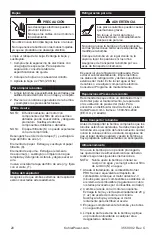
7
35 590 02 Rev. C
KohlerPower.com
EN
Fuel must meet these requirements:
● Clean, fresh, unleaded gasoline.
● Octane rating of 87 (R+M)/2 or higher.
● Research Octane Number (RON) 90 octane
minimum.
● Gasoline up to 10% ethyl alcohol, 90%
unleaded is acceptable.
● Methyl Tertiary Butyl Ether (MTBE) and
unleaded gasoline blend (max 15% MTBE by
volume) are approved.
● Do not add oil to gasoline.
● Do not overfill fuel tank.
● Do not use gasoline older than 30 days.
Add Fuel
WARNING
Explosive Fuel can cause fires
and severe burns.
Do not fill fuel tank while engine is
hot or running.
Gasoline is extremely flammable and
its vapors can explode if ignited. Store
gasoline only in approved containers, in
well ventilated, unoccupied buildings, away
from sparks or flames. Spilled fuel could
ignite if it comes in contact with hot parts or
sparks from ignition. Never use gasoline as a
cleaning agent.
Ensure engine is cool.
1. Clean area around fuel cap (D).
2. Remove fuel cap (D). Fill to base of filler
neck. Do not overfill fuel tank. Leave room
for fuel to expand.
3. Reinstall fuel cap (D) and tighten securely.
Fuel Line
Low permeation fuel line must be installed on
carbureted Kohler Co. engines to maintain EPA
and CARB regulatory compliance.
Spark Plugs
CAUTION
Electrical Shock can cause injury.
Do not touch wires while engine
is running.
Never operate pump in rain or snow.
Never touch pump with wet hands or
electrical shock will occur.
4. Fill crankcase with new oil, up to point of
overflowing filler neck.
5. Reinstall oil fill cap/dipstick (C) and tighten
securely.
6. Dispose of used oil in accordance with local
ordinances.
Oil Sentry
™
(if equipped)
This switch is designed to prevent engine
from starting in a low oil or no oil condition. Oil
Sentry
™
may not shut down a running engine
before damage occurs. In some applications
this switch may activate a warning signal. Read
your equipment manuals for more information.
Assembly of Hoses
Suction:
1. Connect suction strainer (N) to 1 end of
reinforced hose and secure with clamp (O).
2. Insert smaller end of hose joint (R) through
larger end of coupling (P). Connect other end
of hose to hose joint (R) and coupling (P)
and secure with clamp (O).
3. Place rubber seal (Q) at end of hose joint
(R), and attach hose joint (R) to pump
suction port (A). Tighten coupling (P).
Discharge:
1. Connect suction strainer (N) to 1 end of hose
and secure with clamp (O).
2. Insert smaller end of hose joint (R) through
larger end of coupling (P). Connect other end
of hose to hose joint (R) and coupling (P)
and secure with clamp (O).
3. Place rubber seal (Q) at end of hose joint
(R), and attach hose joint (R) to pump
discharge port (B). Tighten coupling (P).
Fuel Recommendations
WARNING
Explosive Fuel can cause fires
and severe burns.
Do not fill fuel tank while engine is
hot or running.
Gasoline is extremely flammable and
its vapors can explode if ignited. Store
gasoline only in approved containers, in
well ventilated, unoccupied buildings, away
from sparks or flames. Spilled fuel could
ignite if it comes in contact with hot parts or
sparks from ignition. Never use gasoline as a
cleaning agent.
NOTE: E15, E20 and E85 are NOT approved
and should NOT be used; effects of
old, stale or contaminated fuel are not
warrantable.








































